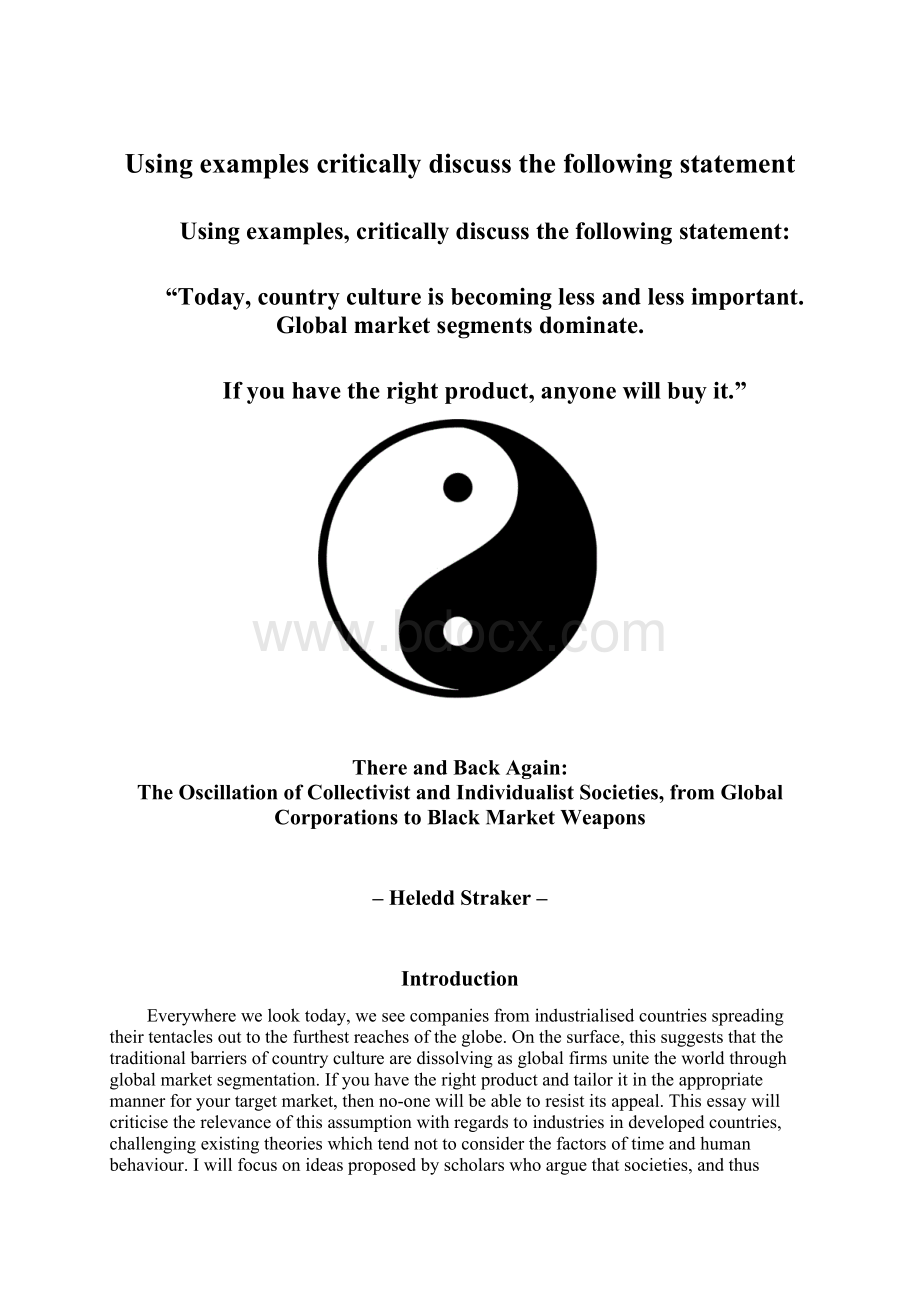Using examples critically discuss the following statement.docx
《Using examples critically discuss the following statement.docx》由会员分享,可在线阅读,更多相关《Using examples critically discuss the following statement.docx(8页珍藏版)》请在冰豆网上搜索。

Usingexamplescriticallydiscussthefollowingstatement
Usingexamples,criticallydiscussthefollowingstatement:
“Today,countrycultureisbecominglessandlessimportant.Globalmarketsegmentsdominate.
Ifyouhavetherightproduct,anyonewillbuyit.”
ThereandBackAgain:
TheOscillationofCollectivistandIndividualistSocieties,fromGlobalCorporationstoBlackMarketWeapons
–HeleddStraker–
Introduction
Everywherewelooktoday,weseecompaniesfromindustrialisedcountriesspreadingtheirtentaclesouttothefurthestreachesoftheglobe.Onthesurface,thissuggeststhatthetraditionalbarriersofcountryculturearedissolvingasglobalfirmsunitetheworldthroughglobalmarketsegmentation.Ifyouhavetherightproductandtailoritintheappropriatemannerforyourtargetmarket,thenno-onewillbeabletoresistitsappeal.Thisessaywillcriticisetherelevanceofthisassumptionwithregardstoindustriesindevelopedcountries,challengingexistingtheorieswhichtendnottoconsiderthefactorsoftimeandhumanbehaviour.Iwillfocusonideasproposedbyscholarswhoarguethatsocieties,andthusmarkets,areinconstantstateofflux.Thismeansthatafirm’s“right”productwillbeeffectiveonlyforalimitedtime,andthatculturesandhumanbehaviour,nomatterhowadversetheymayseem,caneasilyrestraintheactofpurchasingaproduct,nomatterhow“right”itmayseem.
Splitintofourparts,thisessaywillfirstoutlinethecurrenttheories,includingscholarsfightingtheStandardisation-Adaptationbattle,Levitt(1983)andDouglas(1997).Kotler(2004)focusesoninnovation,because,asOshry(1999)argues,societiesshiftandoscillateassystems,suggestingthatafixedstrategy,ofeitheradaptationorstandardisation,wouldlikelyberendereduselessovertime.Asaproposedalternative,argumentsforandagainstMaslow’sHierarchyofNeeds(1954)willbemade,suchasRodgers(2004),inunderstandingandrespondingtochangingmarketneeds.
Inthesecondsection,theseanalyseswillbeappliedtoglobalfirmsCoca-colaandMcDonald’s,todemonstratehowtheirperformancesaffectandareaffectedbysocio-economicshifts.Thethirdpartwilldiscussindustrieswithacurrentlynarrowermarket,suchasVirgin’sGalacticspacetourismandtheblackmarketforsmallweapons,andwillillustratethegreaterextenttowhichtheyareaffectedbytheoscillationofindividualismandcollectivisminindustrialsocieties.
Thefourthsectionwillbetheconclusion,drawingthesecasestogetherandsuggestingthat,althoughCoca-colaandMcDonald’shavesuccessfullyadaptedtheirstandardisedstrategiesinresponsetoindividualisticneeds,theywerereactiveratherthanproactive,questioningthevalidityofstaticframeworksastoolstopredictmarketchanges.WithregardstotheblackmarketweaponsindustryandVirgin’sspacetourism,itwillbesuggestedthatthetheoriesarestillnotdynamicenoughanddonotaccountforhumangreed.
Iwillthusillustratethatbothcountryculturesandglobalmarketsegmentsmatter,astheyfightoneanotherinanever-endingcycle,whichcanonlymeanthat“ifyouhavetherightproduct,anyonewillbuyit”isatoostaticastatementtobeapplicableinthisever-changingworld.
Staticvs.DynamicTheories&Frameworks
“Allcanknowgoodonlybecausethereisevil…
Frontandbackfollowoneanother.”
Tostandardiseortoadapt?
Scholarsseemconstantlytobedebatingandseekingtoprove,onceandforall,thatavariationofoneortheotheristheperfectglobalmarketingstrategy.
Levitt(1983)ferventlystatesthatsuccessfulglobalfirmsshouldstandardiseallvalue-addingactivities.Thisisduetofactorssuchastechnologicaladvancements,whichhaveexposedtheworldtothewondrouspossibilitiesoftheindustrialisedcountries.Thustheworld’stastesbecamehomogenised,aspeoplefromeveryconceivablesocio-economicbackgroundseektoacquirethese‘superior’products.
“Theproductsandmethodsoftheindustrializedworldplayasingletuneforalltheworld,
andalltheworldeagerlydancestoit.”
Hearguesthatcountryculturesarebecomingirrelevant,aspeoplearemorethanwillingtogiveuptheirancienttraditionsforagoodquality,lowcostproduct.
Thereare,however,discrepanciesinLevitt’sargument,forexampleheadvisescompaniestolookforsimilarmarketselsewhere,whichimpliesthattherearealsodissimilarmarketsegmentsinwhichtheproductcouldnotbesold.Douglas(1997)commentsthatcustomersinmaturemarketsaremoredemandingthanthoseinlessdevelopedmarkets,meaningthatfirmsneedtoadapttheirproductstoservetheirdifferingneeds.Douglasagreesthatstandardisationcanbeeffectiveinasmallnumberofcircumstances;however,Douglasconcludesthatfirmsshouldeachadoptahybridstrategyofstandardisationandadaptation,accordingtoindividualrequirements.
Ratherthanadoptinganoverallstandardised,adaptive,orhybridapproach,Kotler(2004)stressestheimportanceofsearchingforwaystopredictthefuture,includingbetterbrandmanagement,bettertechnologiesandmovementsofcompetitors.Societiesareconstantlyshifting,requiringfirmstocontinuallyinnovateandknowwhatamarketsegmenttrulywantsnowandinthefuture.
Indeed,theproblemwithaglobalfirmformulatingandimplementingoneofthementionedstrategiesisthatitmaybeunabletochangeinaccordancewithinevitable,yetseeminglyunpredictablesocio-economicshifts.
Manyhavenotedandtriedtopredictthemovementofsystemsandunderstandhowextremesgiverisetooppositionandreversal.Forexample,KarlMarxinhisCommunistManifesto(1847)predictedthattheindividualiststateofthebourgeoisiewillcausetheoppressedproletarianworkerstobandtogetherandrevolt.Halal(1993)mentionstheparadoxofsocietalintegrationcausinggreaterdiversification,withincreasingnumbersofgroupsseekingindependenceandseparateidentities.
BarryOshry(1999)unitesthesetwoobservationsbyexamininghowandwhysocietiesfluctuate.His‘PowerLab’experimentsshowedhowallsystemsarecomprisedofadelicatebalanceofthreepolarscales,definingvariationsofindividualismandcollectivism,which:
individuateorintegrate;differentiateorhomogenise;andstabiliseorchangeovertime.Whenasocietybecomesunbalanced,oneofthestatesorculturesbecomestoodominant,butasaresult,itsoppositecounterculturerisesup,andtheequilibriumisrestored.Sterman(2000)elaboratesonthedynamicsofcomplexsystems,showinghowcausalloopsanddelaysleadtooscillationsinmanydifferingsituations.
ThisconstantshiftingofsocietieswasobservedinDaoism,wellbeforetheinventionofWesterneconomics.LaoTsudescribesthemeaningrepresentedbytheYinandYang,whereeveryelementintheuniverseformspartofanever-endingcycleofinterdependent,alternatingopposites.Fromthecreationofsimilarglobalmarketsegments,dissimilarmarketsegmentswillarise.Fromthecollectivismcausedbystandardisation,individualismwillarise,assertingtheneedforadaptation.
WhileOshrymakesgeneralobservationsofsocietalmovements,Keegan&Green(2003)andKeegan&Schlegelmilch(2001)suggestthatMaslow’sHierarchyofNeeds(1954)providesaspecificdescriptionandexplanationforpeople’schangingneeds.Accordingtothistheory,humansdevelopbyprogressingupwardsthroughlevelsofdesires,beginningwithPhysiologicalrequirements,suchasfoodandsurvival.Oncetheseneedshavebeensatisfied,peopleprogressupthescaletoSafety,andthentohigherordersocialneeds,BelongingandEsteem,andfinallytoSelf-Actualisation.Thesechangesofneedsalsoechotheshiftingofindividualandcollectivebehavioursofpeople,forexample,psychological,safety,andesteemneedsareindividualist,whilebelongingandarguablyself-actualisationneedsarecollectivist.
Rodgers(2004)providesanargumentagainstMaslow’sframework,statingthatitistoorigidandthatpeople,dependingonthecurrentsituation,canalternatebetweenoroccupylevelssimultaneously.Thissuggeststhat,althoughMaslow’stheoryismoredynamicthantheStandardisation-Adaptationanalyses,itstilldoesnotaccountforthefactthatsocietiescanchangedirection.Asaresult,thefollowingcaseswillbediscussedintermsofthementionedtheories,butasmostcannotaccountforeverysituation,itwillbemadeclearthattheframeworksarenotperfectexplanations,justthatsomearebetterthanothers.
"Coca-Colonisation”?
Thesuccessoftwoofthelargestnamesintheworld,Coca-colaandMcDonald’s,canbeunderstoodintermsofLevittandDouglas.Coca-cola’shighlyrecognisablename,typeface,bottleshape,taste,andpromotedimage,areidenticaleverywhereintheglobe,makingittheperfectexampleofthesuccessfulglobalstandardisationstrategypromotedbyLevitt.Inaddition,itissoldinshops,restaurantsandvendingmachines,inover200countries,implyingthatcountrycultureisirrelevant.DeChernatony&McDonald(1998)attributeCoke’ssuccessthroughtheemotionalvaluesaddedbyitspowerfulbrandingandclearpositioningoftheproductasanAmerican,fundrinkaimedatyouthculture.Itsslogan“EnjoyCoca-cola”evokesapleasurableemotion,enjoyment,inthemindoftheconsumer,closelylinkingitwiththebrand.Theverb“enjoy”isinpresenttense,implyingtheconsistencyandsustainabilityofthispleasurableCokeexperience.
McDonald’s,althoughpraisedbyLevittforbeinganexemplarofimplementingglobalstandardisedstrategies,hasadoptedahybridstrategyassuggestedbyDouglas,usingonlylocally-producedfoodontheirmenus.Thissavesonthecostsoftransportandthepreservat